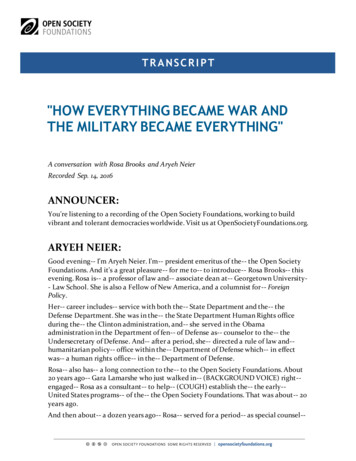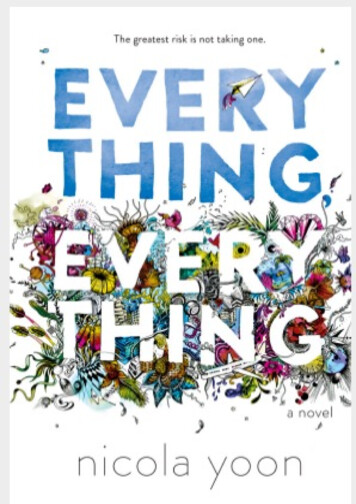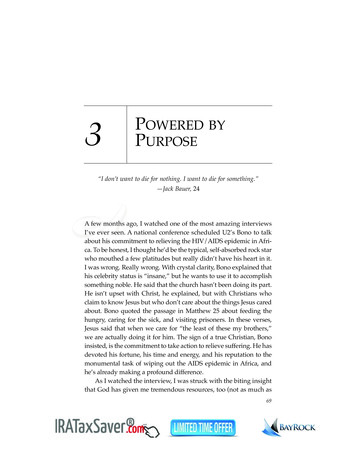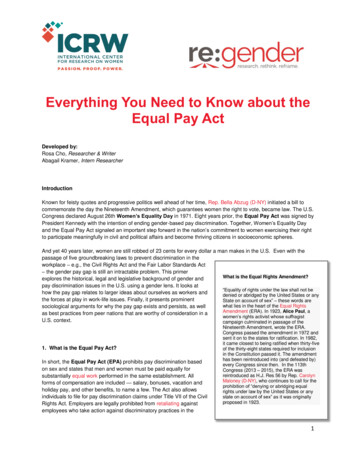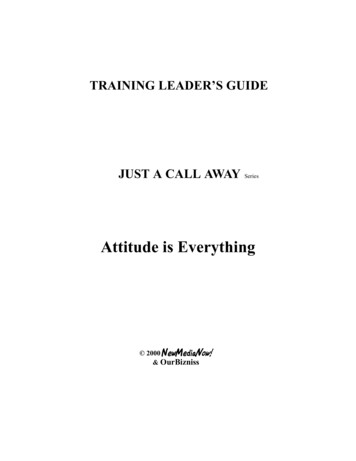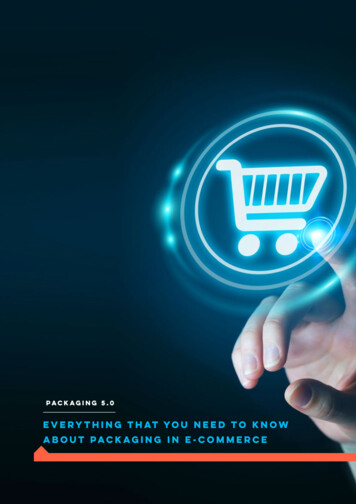
Transcription
Packaging 5.0Everything that you need to knowabout packaging in e-commerce
Packaging 5.0 –Everything that you need toknow about packagingWhether you are a large or small company, a start-up or a long-established company, with a great deal of or very littleprior knowledge – our e-book providesevery reader with various facts and information on many different fields of knowledge relating to the important topic ofe-commerce packaging.in e-commercePreface03Introduction05Section 1:Packaging basics07Section 2:Packaging in the e-commerce supply chain37Section 3:Packaging as a marketing tool53Summary66About Schumacher Packaging68Company informationOur e-bookcontains thefollowing: Extensive basic information about thetopic of packaging – from materials tofunctions to printing Special packaging requirements ine-commerce – and new solutions The marketing benefits of yourpackaging Numerous practical examples andclear illustrations Tip and tricks for you to put intopractice69 Useful checklists for implementation23
VDW study*: Looking ahead to the futureStarting with mega trends – which we could alsorefer to as meta trends – not only is society andthe economy currently changing, so too is theway in which the customers tick and processes work in the consumer business, in commerceand especially in online commerce. Overridingtrends and development drivers in this area include sustainability in all markets and corporatedivisions, the digital interlinking of products,processes and other elements within the supplychain, the dynamism and globalisation of markets, along with the increasing personalisationof the purchasing ng5.0These trends both influence and fuel each other. The economy in general, the various sectors and the individual companies must find asuitable response to these issues – solutionsthat are more transparent, faster, automated,customer-specific, flexible and cover the entiresupply chain. Where packaging is concerned,this means enhancing its basic functions (seeSection 1): From product protection and information transfer to the creation of a supply chainwhich is superordinate to the pure goods flow(see Section 2) through to image cultivation andemotionalisation (see Section 3). As a result,according to the summary of the VDW study,the packaging of the future must be reliable,sustainable and intelligent, as well as customer-specific and emotional.ProfitabilityLightnessE-commerce boom and digitalisationPackaging 5.0Digitalisation has for a long time been triggering one innovative wave after another – from Web 2.0to the Internet of Things and Industry 4.0. And it is far from reaching the end of its revolutionarypower. It has also pushed the area of packaging to take a major step forwards: Packaging 5.0 is theanswer to the changes in society that are associated with the e-commerce boom and digitalisation– both regarding consumer behaviour and a wide variety of industrial sectors. Packaging 5.0 is creative, with almost limitless design possibilities, sustainable and characterised strongly by modernpaper-based material compositions. At the same time, it is easy to handle, making it cost-effectiveand fit for the future. This means that companies can already use next generation packaging andbenefit from its advantages today.4* The "Supply Chain 2025" study was published in 2015by the German Zukunftsinstitut think tank and was commissioned by the Verband der Wellpappen-Industrie e.V.(VDW) (German association of the cardboard packagingindustry), of which Schumacher Packaging is also a member, and is available to download free of charge plychain-2025/.5
Section 1The role of packaging in online commerce E-commerce packaging – the basics Diverse functions of the packaging Film, paper or cardboard? – Deciding on the material Packaging types according to level of automation Under pressure with regards to printability?67
The role of packaging in online commerceE-commerce packaging – the basicsEvery day, millions of packages in Germany make the journey from an online shop to a customer.Without packaging – whatever form it takes – this would not be possible and online commerceitself would be inconceivable. There are four important aspects to consider when selecting the rightpackaging: IntroductionFrom a logistical necessity to apromising marketing toolDispatch vs. product packagingOnline commerce is booming worldwide. In Germany alone, e-commerce sales have tripled1 in thepast ten years. However, many online retailers continue to underestimate how important having thecorrect packaging is to ensuring sustainable business success. After all, one thing is indisputable:"There is no e-commerce without packaging."The requirements for packaging in online commerce are growing. From the highest possible efficiency and sustainability in the supply chain, to increasingly popular logistics trends such as bicyclecouriers and delivery drones, through to "last mile" delivery and the all-important marketing purpose vis-à-vis the customer – all this is resulting in new demands. And as for the dispatched goods,the e-commerce motto "just in time" also applies to packaging: Available quickly, packaged simply,delivered as required.The packaging materialThe level of automation during manufacturingThe printing requirementsThe function of the packaging.What exactly is packaging?DIN 55405 specifically sets out what is understood by the term "packaging". In addition tothe physical packaging enclosing a product –i.e. the material protecting the goods for transportation or storage purposes, or relating tomarketing – the term "packaging" also refersto the unit comprising the packaging container (e.g. a carton or folding box), the packagingmaterial (e.g. corrugated board) and packagingaids (e.g. adhesive tape, filling material and labels). Goods which are placed in the packagingare referred to as packaged goods. By packingthe packaged goods in the packaging, a packaged item is created ( the goods and the product packaging). Only when this is packed intoa transport or shipping unit is this referred toas the package ( the goods and their dispatchpackaging), which may comprise multiple packaged items or multiple packaged goods.1 faktengrafiken/item/110185-e-commerce-umsaetze.89
Packaging materiale.g. paper, glass, plastic, metalPackaging aidse.g. labels, closures, foamPackagingmateriale.g. bottle, folding box, bagPackagingPackaged goodsPackaged itemPackageFrom the packaging material to the packageImage source: Schumacher Packaging10Dispatch vs. product packagingA distinction can generally be made in e-commerce between product and dispatch packaging. This refers either to the product's salespackaging, as well as that on the shop shelves,or the packaging in which the product is placed(including any product or sales packaging) fortransportation to the customer. In special cases – for example when shipping magazines (filmpackaging) – the product and the dispatch packaging are, however, identical. Here, the addressinformation is simply added as a label or usinga delivery note adhered to the paper envelopeor film cover. However, as a general rule, onlineretailers (as well as manufacturers with their ownonline shop) need dispatch or transport packaging in order to transport and deliver their goodsto the customer. Therefore:"E-commerce packaging generally refers to dispatch or transport packaging."11
Section 1: The role of packaging in online commerceDiverse functions of the packagingSpecial feature: E-commerce packagingThe special feature of dispatch packaging in online commerce is that selection of suitable packaging primarily depends on its function. Here, theunboxing experience, the influence on post-purchase decisions, sustainability requirements,ease of returns, product variety, protection requirements and much more play a role. In turn,all these requirements have an impact on thematerial used, the required level of automationand the printing of the packaging.The packaging used to dispatch items ordered online needs to fulfil a large number of functions.This primarily includes physical functions such as protecting the goods contained therein and meeting requirements with regards to the storage and transportation of packaging and of the finishedpackage. However, for online commerce in particular, the marketing, information and guaranteepurpose of packaging also plays an important role."E-commerce packaging must be based on its function."This sets out the key selection criteria. Bear in mind: The weighting of special requirements which arelaid down by the corresponding corporate divisions such as marketing and logistics can, under certaincircumstances, also be used to attribute packaging costs to the individual departments.Protective functionPackaging must protect its contents from being lost and/or stolen as well as from dirt, damage anddestruction. The aim is to retain the practical value of the packed product. To do this, the packagingmust be able to withstand the mechanical and climatic influences (e.g. frictional, pressure and impact forces, along with temperature changes, solar radiation and moisture) both in the packaging,transport and loading processes and during storage. Sometimes it is also necessary to protect theenvironment and people from any adverse influences by the content – not least including hazardousgoods.1213
Transport functionThe protective function is closely related to thetransport function: The size and shape of thepackaging, the quantity of the goods containedtherein and the use of packaging aids mustmeet protection as well as handling requirements. The latter primarily requires the packaged items and packages to be easy and secureto grip, as well as to be easy to move, stack andstore. This makes transportation safe, effectiveand efficient. Of course this requires the packages to enable comfortable handling thanks totheir shape and stability.Information functionPackaging is also always used to conveyinformation about the product and/or handling. On product packaging, this includesdetails regarding the goods contained inthe packaging and the composition thereof, e.g. nutritional values, filling capacities,dosing information, etc. This is in accordance with the legitimate consumer question: "What is actually in this?" On dispatchpackaging, the printed information also relates to the content, but is generally used toprovide information for transportation, suchas information pointing out it is fragile or"This side up" markings.Another aspect which needs to be taken intoconsideration with regards to the transportfunction of packaging is the formation of loading units and corresponding dosing and/or removal options – for example, orientated to thedimensions and load-bearing capacity of standardised transport pallets.In online commerce, packages are generally loaded manually. E-commerce packagingshould therefore make manual handling as easyas possible.Storage functionIf packaged items or packages are not being loaded or transported, they are usuallyin storage. In such cases, both stackabilityand static loading capacity is required. Inaddition, the online retailer must store thepackaging before it is filled, along with packaging materials, packaging containers andpackaging aids. However, because storageprocesses always incur costs, the packagingmust be stored such that it takes up as littlespace as possible and so that it can be readyto use quickly.14Sales and marketing functionIn terms of the sales and marketing function ofpackaging, a distinction must again be madebetween product and dispatch packaging. Onproduct packaging, the design and informationon it plays an important role by initially enablingthe sales process and/or positively influencingit. With dispatch packaging, which is more relevant in e-commerce, and which under somecircumstances also contains different types ofgoods, the requirement was also to use thepackaging for advertising and sales purposes,although this has for a long time been second tothe protective and transport function. However,these days, this marketing aspect is becomingincreasingly important: How can the moment atwhich the package is received and unboxed bemade to be as attractive as possible? How canthe packaging have a positive impact on thepost-purchase phase?Answers to these questions and many others relatingto the marketing function of the packaging can befound in Section 3 from page 54 onwards.15
Function Requirements for packagingService functionTo what extent does the packaging act as aservice? In addition to the basic requirementsfor storage, transport and handling, ease oferecting, opening and filling of packaging isalso an important function. Further handlingof the packaging is also relevant – whether forthe purpose of easy returns or storage, e.g. ofa toy, or for easy recycling of packaging materials, packaging containers and packagingaids. Consumers' growing awareness of sustainability plays an important role here.Packaging complexitylowProtective function Stability to protect the goods Sealed to protect the environment Resistance to mechanical andclimatic influences Shoes Transport function Easy and secure to grip Easy to move, stack and store With dosing/removal optionsGuarantee functionThe guarantee function is a special form of information function which predominantly relatesto product packaging. Fully intact and undamaged, sales packaging provides a guaranteefrom the manufacturer that the packaging contains what is specified on the outside. Thus theproduct packaging forms the basis for the brandpromise, trademark and consumer protection aswell as product liability. This also includes statutory provisions (e.g. German Youth ProtectionAct [Jugendschutzgesetz] or the German Ordinance on Foodstuffs [Lebensmittelverordnung])which require the type, composition, shelf life,etc. of the products to be marked on the packaging. However, dispatch packaging may alsobe subject to a labelling obligation. And defectsin the dispatch packaging entitle customers toreturns and the reimbursement of costs if thegoods contained therein have been damagedor become lost as a result. highVintage wine Storage functionStackabilityStatic loading capacitySpace-savingReady to use quickly Information function Information about the product Information regarding handling Easy printability Service function Reusability Recyclability Printability Guarantee function Printability of brand promises, trademark protection,labelling obligation Stability and seal as guarantee Sales and marketing function Eye-catching Attractive Contributes to post-purchase satisfactionand branding Various printing options With dispatch packaging, which is of key importance for e-commerce, the content determines thecomplexity of the requirements for the packaging. Fragile products must be packed particularlysecurely, high-quality goods must be packed in theft-proof packaging, etc. The following exampleillustrates the relation between the product and the packaging complexity.The more complex and extensive the range of functions to be met, the more complex the packaging: Robust products such as clothingand shoes (provided they are not part of an upscale brand range) require less protection and less information to be conveyed than exclusive vintage wines, for example. With these items, the packaging is significantly more complex. The diagram illustrates how the requiredpackaging functions impact the complexity of the packaging for the product group of shoes or vintage wines respectively.1617
Section 1: The role of packaging in online commerceFilm, paper or cardboard? – Decidingon the materialOnline retailers must consider what material their e-commerce packaging should be made of depending on which items are being dispatched and what functions are required of the packaging.Anti-theft protection: How can the packaging contribute to this?When shipping high-value goods such as perfumes, jewellery or electronic devices, the security of the product is particularly important. Ifthe goods are not received by the recipient, orif the goods are incomplete, this not only resultsin financial loss for the sender, but also a loss ofconfidence amongst their customers, who maysubsequently order from another provider. Theouter seal of the packaging is a guarantee tothe recipient that their package has not beenopened en route. In addition, adhesive closuresmake it harder for criminals to open packagesand remove goods.However, with exported goods, adhesive closures can be a disadvantage if the post office orcustoms need to inspect the package. Packaging that is difficult to open is also not convenientfor the recipient. For this reason, there shouldalways be a balance between handling and convenience on the one hand and the protection ofgoods on the other. However, online retailers cansecure the packaging not only by closing andsealing it sufficiently, but also by making it lookas inconspicuous as possible, for example by anonymising the sender and omitting the advertising imprint. As a result, the packaging gives noindication that it contains goods of a particularly high value. The less incentive there is for thepackaging to be stolen, the more likely it is that itwill arrive at the customer safely.However, you can find out how packaging can meet your marketingneeds anyway in Section 3 from page 54 onwards.1819
Film packagingOnline retailers like to use soft film packagingfor clothing. This is ideal for most items madefrom fabric, i.e. content which is flexible and haslittle need for protection. However, film packaging is not ideal for products with special protection requirements, e.g. those which must not bebent, broken or deformed. Nevertheless, plastic bags and film packaging keep the packedproduct clean, are lightweight, take up very little space and are cost-effective for the retailer.The disadvantage is that they are difficult tostack, they attract dust (via electrostatic attraction) and, under certain circumstances, makeimprints and labels harder to read. In terms ofsustainability, film packaging does not scorewell as it has mineral oil as its raw material. Customers therefore consider film material and thecostly recycling associated with it as a largelynegative aspect.Paper packagingSimple paper packaging, such as a paper envelope, offer a cost-effective and lightweightalternative to film packaging, particularly forflat, robust goods. Paper is also environmentally friendly and requires less space in packagingwarehouses. However, paper dispatch packaging does not have a protective buffering effecton the product (even if it is in its own productpackaging). For transport and storage, thestackability then depends on the product packaging and for returns, paper packaging canbarely ever be reused.20What is the difference between paper,paperboard, corrugated and solid board?Generally speaking, paper, paperboard andboard raw or packaging materials are manufactured from similar basic materials and using similar processes. They are distinguishedby their grammage and/or mass per unit area.According to DIN 6730, paper is defined as 7g/m² to 225 g/m² and board from 225 g/m².According to EU standards, the term "paperboard" does not exist, but broadly speakingpaperboard is a thicker kind of paper which ispressed or couched ( layered whilst wet) in thesame way to solid board from multiple paperwebs or which is glued. With a mass per unitarea of around 150 to 600 g/m², paperboardis between paper and board. In Germany, thefollowing differentiation has therefore become widespread: Paper has a grammage of 7g/m² to 150 g/m², paperboard of 150 g/m² to600 g/m² and board of over 600 g/m².The number of flutes in conjunction with the paper composition determines the technical characteristics of the corrugated board, for examplein terms of the ease with which it can be piercedor its edge crush resistance as well as its functional features. The corrugated board liners areparticularly robust and resistant to tearing, andare easy to print on. Unlike corrugated board,solid board can be couched as one layer or multiple layers or glued in multiple layers. There areno air spaces between the layers as there arewith corrugated board, which makes the packaging material particularly solid and dense. It isdifficult to compress and has a high resistanceto moisture. Due to its smooth and sealed surfaces, solid board offers the same printing options as corrugated board.21
LinerGluing andpressing areaPressure beltCorrugated boardglued on one sidePaper machineHeadboxSieve sectionPress sectionReelDryer sectionCalenderSieve waterGlue applicationCorrugation/embossingSieve waterPress waterCorrugatingmediumWaterHow is corrugated and solid board produced?Corrugated board comprises various paperwebs made of corrugated paper which areglued to one another: One or more corrugatedpaper webs – known as the flute – are gluedbetween two smooth paper webs or liners. Corrugated board is made in corrugator machines.Using heat, pressure and moisture, special corrugating rolls give the flute its shape. Then thecorrugating medium is glued to a smooth paperweb. This one-sided corrugated board can noweither be glued to additional layers of one-sided corrugated board or be finished directly witha smooth paper web as the outer cover. Correspondingly, we refer to one-flute, two-fluteor three-flute corrugated board. The numberof flutes in conjunction with the paper composition determines the technical characteristicsof the corrugated board, for example in termsof the ease with which it can be pierced or itsedge crush resistance as well as its functionalfeatures. The corrugated board liners are particularly robust and resistant to tearing, and areeasy to print on.Solid board or paperboard is made from wastepaper and pulp. First, a liquid pulp is producedfrom the relevant paper types. This is then highly diluted with water and fed over a roll to anendless, continuously moving wire sieve, wheremost of the water drains away immediately. Thefibre fleece left behind is guided between multiple rollers. These push out any remaining waterand press the fibres into various calibre thicknesses of 200 g to 1050 g/m². By combiningvarious layers, different board qualities can beachieved. Unlike corrugated board, solid boardcan be couched as one layer or multiple layersor glued in multiple layers. Unlike corrugatedboard, there are no air spaces between the layers, which makes the packaging material particularly solid and dense. It is difficult to compress and has a high resistance to moisture. Dueto its smooth and sealed surface, solid boardoffers the same printing options as corrugatedboard.22Packaging made from corrugated and solidboardIn e-commerce, dispatch packaging made frompaperboard and/or solid/corrugated boardis used most frequently. This is because thesematerials provide a buffer and (dimensional)stability so that the goods contained thereinare optimally protected against any mechanicalinfluences during storage and transportation.This means that online retailers can significantly reduce their number of returns due to damaged items. In addition, the corrugated andsolid board packaging is relatively low cost andtherefore highly cost-effective. Good recyclability is also a real plus due to the economic aspectof disposal and consumer perception.The topic of sustainability is becoming increasingly important to many consumers (see note onpage 24). Furthermore, packaging made fromcorrugated and solid board offers convenienthandling, is easy to stack and can be printedwith information or advertising slogans on boththe interior and exterior in a number of ways.23Pope reel
Why is sustainability becoming more and more important with regards to packaging?Numerous studies show that sustainability is being given increasingly high priority within our society. One important parameter is the CO2 level or "carbon footprint" as the level contributed byall greenhouse gas emissions throughout the relevant product lifecycle – from material extractionto manufacturing, distribution and use to disposal and/or recycling. This change in values is alsohaving an impact on the requirements being placed on packaging by companies and consumers.For example, in its "ALL4PACK Paris 2016 European Survey", the French market research instituteL‘ObSoCo established that German consumers generally pay attention to the environmental sustainability of packaging.2 The EHI Retail Institute, well-known in the German-speaking DACH region(Germany, Austria and Switzerland), also revealed in its study entitled "Versand- und Retourenmanagement im E-Commerce 2014" [Dispatch and returns management in e-commerce 2014] thatsustainable packaging can be a decisive factor in creating a positive experience when the orderedgoods arrive: Around four out of five consumers (79 percent) considered it important that excesspackaging material is disposed of and a good half (51 percent) thought it was important for thepackaging to be made of environmentally friendly materials.3"When choosing their dispatch packaging, online retailers shouldbear in mind the growing awareness of sustainability."Packaging made from corrugated board and paperboard has a major advantage here. It is rightfullyregarded as especially sustainable because it is made from renewable resources with a high recycling rate. For corrugated board, this recovery rate is almost 100 percent.Section 1: The role of packaging in online commercePackaging typesaccording to level of automationAlongside the functionality and material used, the packing process also plays an important rolewhen selecting suitable packaging. With boxes and cardboard boxes made from corrugated board,we distinguish between them by their automation level: Are they erected by a machine (automatically) or manually? Filling is generally a manual process.Manual erectinghas the advantage that capacities can be madedynamic and peak requirements are easier toabsorb.0201 American BoxThe simple 0201 folding box with outer flapsthat all close in together is particularly cost-effective but time-consuming to erect.2 3 perpad&boardlidsoPackagstry & comdumIneclingcyRe24Packaging made from corrugated and solidboard – a sustainable cycle: Packaging madefrom corrugated and solid board comprisesnaturally derived, renewable raw materialswith a correspondingly beneficial carbon footprint. In addition: The recycling rate for usedtransport packaging is nearly 100 percent inGermany. All paper, corrugated board and paperboard which is thrown away is used to makenew packaging. (Image source: SchumacherPackaging)25
AUTOMATIC erectingSelf-adhesive packaging with tear stripsSelf-adhesive packaging is easy to erect andflexible and quick to seal, but is slightly moreexpensive.has a static capacity and is therefore suitablefor the general basic load of packaging. Automation is quick and separates erecting fromfilling, which makes the packing process moreefficient, but also restricts flexibility. After all,every automatic erecting system is fixed to therelevant size of the packaging.Automated gluing processWith folding boxes such as the 0201 AmericanBox and telescope-type boxes, pre-glued packaging makes the manual filling and/or packingprocess must simpler.GRPESUTelescope-type box or four-point trayThe telescope-type box always comprises at leasttwo parts: Although this makes manual handlingmore difficult, the packaging is easy to fill andthe design allows sufficient flexibility regardingthe height of the packaging – depending on theextent to which the lid and the base overlap.26GINKATray erectorsTray erectors make the packing process easierbecause then the boxes only need to be filledand sealed.CPASpecial/fanfold designsWith special fanfold designs, packaging canvary in size. This offers maximum flexibility at ahigher cost.27
Section 1: The role of packaging in online commerceUnder pressure with regards to printability?Beyond the material-specific grey, brown and white, packaging can be designed in various waysthanks to different printing techniques. Selecting a suitable printing process is often a real headachefor online retailers. However, making the correct decision always depends on specific individual requirements – primarily the information, marketing and guarantee function of the packaging. Whatneeds to be on the packaging? How should the packaging look?Answers to these questions and many others relating to the marketing function of thepackaging can be found in Section 3, page 54.FLEXO PRINTINGWhat is fanfold corrugated board?In e-commerce in particular, a fast and smoothpacking process is a key factor for success. Onlineretailers are increasingly faced with the challengeof having to pack items of different sizes. Thisrequires special packaging which can often onlybe ordered in specific quantities and then alsoneeds to be stored accordingly. Fanfold corrugated board offers an efficient and flexible solution– one type of packaging for all products. Fanfoldcorrugated board is pre-scored, which not onlymeans that it can be easily manually folded andpacked around an item, but that it can also beused in packaging machines and on conveyorbelts. It is stored in a zigzag fold on a pallet sothat a packer only takes as much board as theyneed in each case.Traditionally, this type of corrugated board is useful for packaging requirements in the furniture industry and for large bulky goods, although it is increasing in popularity in
every reader with various facts and infor - mation on many different fields of knowl-edge relating to the important topic of e-commerce packaging. Our e-book contains the following: Extensive basic information about the topic of packaging - from materials to functions to printing Special packaging requirements in
